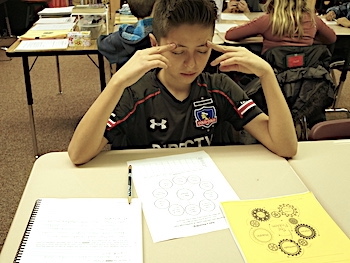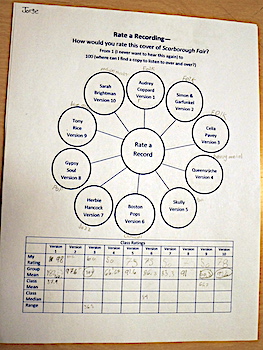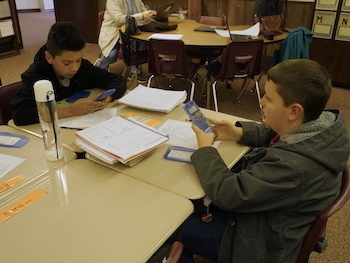SUBJECTS
GRADE
Show Results
Rate a Recording
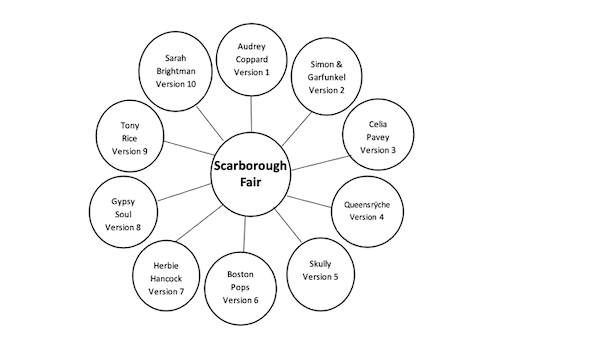
Lesson Summary
- Explore various genres of music and rate different covers of “Scarborough Fair."
- Find the mean, median, and range of ratings within the group.
Lesson Plan and Procedure
Lesson Key Facts
- Grade(s): 6
- Subject(s): Math, Music, Social Studies
- Duration of lesson: 45-60 minutes
- Author(s): Emily Soderborg
Essential questions: How can one song be performed in many different styles? What are some specific traits of “Scarborough Fair” that carry over to each version?
Teacher: We have listened to several Renaissance-style music recordings. This style of music is still being produced today because some people still choose to listen to this type of music. What other genres of music are popular today? (Make a list on the board of popular music genres, e.g., pop, rock, country, hip-hop).
Teacher: Today we’re going to listen to covers, or arrangements, of “Scarborough Fair” recorded in different genres. ”Scarborough Fair” has been recorded many, many times. In fact, there are over 800 versions on iTunes alone.
Teacher: Even though these arrangements are in many different styles, there will be aspects of “Scarborough Fair” that will stay the same throughout all of the recordings. What stylistic traits do you think will stay the same? (Make a list of students’ ideas on the board.) Please continue to look for more traits we may have missed as we listen.
As you make a list on the board, here are some traits you can suggest to students to help them describe traits of “Scarborough Fair”:
- Repetitive melody
- Distinct phrases
- Steady beat
- Dance-like
- Triple meter (3/4)
- Dorian mode (A mode is a type of scale coupled with a set of characteristic melodic behaviors. On a keyboard you could play the Dorian scale from D to D with all the white notes [no sharps or flats] played, D-E-F-G-A-B-C-D. It contains a minor 3rd and minor 7th, so it is similar to a natural minor scale. If you play “Scarborough Fair” starting on D, you can play the entire melody on white notes.)
- Antecedent—consequent phrases (Antecedent phrases feel unfinished, and the consequent phrase gives it a completed feeling.)
- AAA song form (This form consists of several verses; it doesn't have a chorus or bridge. This song does, however, have a refrain, which is repeated at the end of every verse.)
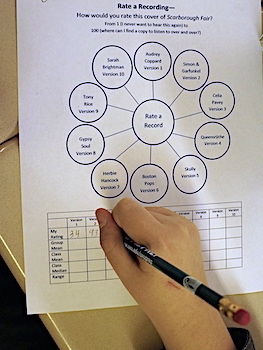
Teacher: We’re going to score each recording as we listen to it today. The more you like the recording, the higher a score it gets. 100 is the highest score (use this when you really like a version), and 1 is the lowest score (use this if you really dislike the version). We’ll start with some of the recordings we have already heard, and then we will add in some new styles. I’ll let you talk about your opinions after we are finished listening. Right now you will need to listen silently and write a number in each box of the row labeled “My Rating.” Remember, each person is entitled to his or her own opinion. The fact that you like something does not mean someone else needs to like it, and your disliking something does not mean someone else is wrong if they do like it.
Have students listen and write their personal ratings. Play about 30 seconds, or approximately one verse of the song, in each style. As necessary, remind students to listen silently.
| Versions of “Scarborough Fair” | ||
|---|---|---|
| Style | Artist(s) | Reference |
| Folk | Audrey Coppard | (1956). Scarborough fair. On English folk songs [iTunes]. New York, NY: Folkways Records.] |
| Folk | Simon & Garfunkel | (1999). Scarborough fair/ canticle. On The best of Simon and Garfunkel [iTunes]. New York, NY: Sony Music Entertainment Inc. |
| Folk | Vera Blue (as Celia Pavey) | (2013). Scarborough fair. On This Music [YouTube]. Sydney, Australia: Universal Music. |
| Heavy metal | Queensrÿche | (2010). Scarborough fair. On Empire (20th Anniversary Edition) [iTunes]. Hollywood, CA: Capitol Records. |
| Pop | Skully | (2008). Scarborough fair. On Irish makeover [iTunes]. Cork, Ireland: Blind Faith Digital. |
| Orchestral | Boston Pops Orchestra | (2005). On 20th century masters the millennium collection: The best of Arthur Fiedler and the Boston pops [iTunes]. Santa Monica, CA: Universal Music Enterprises. |
| Jazz | Herbie Hancock | (1996). Scarborough Fair. On New standard [iTunes]. Santa Monica, CA: The Verve Music Group. |
| Pop | Gypsy Soul | (2001). True love (Scarborough fair). On Superstition highway [iTunes]. Sheffield, MA: Off The Beaten Track. |
| Bluegrass | Tony Rice | (1975). Scarborough fair. On California autumn [iTunes]. Charlottesville, VA: Rebel Records. |
| Musical theater | Sarah Brightman | (2000). Scarborough fair. On La luna [iTunes]. New York, NY: Nemo Studios under license to Angel Records. |
Note: If you cannot find any of these renditions, others may be substituted. If you Google-search “Scarborough Fair” and a specific genre, it will usually find several options. The worksheet is editable, so you can change the songs as necessary.
Teacher: I didn’t want to sway your listening by telling you the style before you listened to each piece. However, now that you have your ratings, please write the genre next to the side of each circle in the graphic as I read them off to you. This will help you remember which piece was which as we discuss them today.
Read the genres out loud from the table above.
Teacher: We are going to collect the class’s data of how individuals rated each song based on personal preference. We can see different patterns as we look at the data, using various statistical methods. We’ll look at the mean, median, and range today. The mean is the technical term for what we commonly call the average.
Model for the class how to figure out the mean for the Audrey Coppard recording, using one group’s numbers. If students need more practice, figure out the mean for the Audrey Coppard recording again while using another group’s numbers.
When students are ready to do the math on their own, have them discuss their responses in small groups. They should figure out their group’s mean for each recording. Also, have them figure out which recording out of the 10 had the highest mean and circle it; then have them figure out which recording out of the 10 had the lowest mean and underline it.
Come back together, and (as a class) find the mean, median, and range of the class’s ratings. Talk about why the ratings of the different covers are a good example of a statistical question.
Compare the best-liked version with the least-liked version. Discover which version had the widest range of answers.
Teacher: Who do you think might be interested in the type of data that we collected today? (Music producers, musicians, companies that sell music like iTunes or Amazon, and so on.) Have any of you seen the popularity ratings for songs on iTunes, or the five-star ratings on Amazon? That’s similar to what we did today. Are you more likely to listen to a song that other people have given a high rating? Why or why not?
Teacher: What do you like about these different covers? Why do you like those things? What were things you didn’t like? Why didn’t you like those things?
Teacher: Let’s look at our list of stylistic traits again. What traits of “Scarborough Fair” did you hear carry over in all of the different versions? Were there other things that you heard in every recording that we didn’t list on the board? Were there traits we originally listed that did not carry over between the recordings? If you were to create your own cover of “Scarborough Fair,” what style would it be?
Assessment
- Create a list of stylistic traits of “Scarborough Fair.”
- Rate recordings of “Scarborough Fair.”
- Find the class mean, median, and range of the ratings of “Scarborough Fair” recordings.
Learning Objectives
- Understand the transformation of cultures during the Renaissance and the impact of this transformation on modern times.
- Listen to and interact with a variety of contrasting music and genres.
- Identify connections between music genres and cultural or historical contexts.
- Find the mean, median, and range of numerical data sets.
Utah State Board of Education Standards
This lesson can be used to meet standards in many grades and subject areas. We will highlight one grade’s standards to give an example of application.
Grade 6 Social Studies
Strand 2: Globalization: Students will compare how the transformation and changes of the post-classical era (Ca. 500 C.E.–1500 C.E.) set in motion the expansion of knowledge through science, language, writing, religion, and technological innovations. They will understand how this created and encouraged a global interconnectedness among distant societies and civilizations that ripples into modern history.
Grade 6 Music
Standard 6.M.R.1: Listen to and interact with a variety of contrasting music.
Standard 6.M.R.2: Listen for and identify form, meter, rhythm, timbre, dynamics, tempo, melody, texture, and harmony/tonality.
Standard 6.M.R.5: Identify possible intent of a music selection, and how the music elements are used to convey it.
Standard 6.M.R.7: Identify music elements that are characteristic of different genres of music.
Standard 6.M.CO.3: Experience and explore music which connects us to history, culture, heritage, and community; identify connections between a music genre and cultural or historical contexts; and explore and explain how musical works are influenced by a composer's heritage and experiences.
Grade 6 Math
Standard 6.SP.1: Recognize a statistical question as one that anticipates variability in the data related to the question and accounts for it in the answers. For example, “How old am I?” is not a statistical question, but “How old are the students in my school?” is a statistical question because one anticipates variability in students’ ages.
Standard 6.SP.2: Understand that a set of data collected to answer a statistical question has a distribution that can be described by its center, spread/range and overall shape.
Standard 6.SP.3: Recognize that a measure of center for a numerical data set summarizes all of its values with a single number, while a measure of variation describes how its values vary with a single number.
Standard 6.SP.5: Summarize numerical data sets in relation to their context, such as by:
Reporting the number of observations.
Describing the nature of the attribute under investigation, including how it was measured and its units of measurement.
Giving quantitative measures of center (median and/or mean) and variability (interquartile range and/or mean absolute deviation), as well as describing any overall pattern and any striking deviations from the overall pattern with reference to the context in which the data were gathered.
Relating the choice of measures of center and variability to the shape of the data distribution and the context in which the data were gathered.
Equipment and Materials Needed
- Documentsrate-a-recording-worksheet.pdf (115.61 KB)
- Recordings of “Scarborough Fair”
- Audrey Coppard, folk:
Coppard, A. (performer). (1956). Scarborough fair. On English folk songs [iTunes]. New York, NY: Folkways Records. - Simon & Garfunkel, folk:
Simon, P. & Garfunkel, A. (performers). (1999). Scarborough fair/ canticle. On The best of Simon and Garfunkel [iTunes]. New York, NY: Sony Music Entertainment Inc. - Celia Pavey (The Voice), folk:
Pavey, C. (performer). (2013). Scarborough fair. On This Music [YouTube]. Sydney, Australia: Universal Music. - Queensrÿche, heavy metal:
Queensrÿche (performers). (2010). Scarborough fair. On Empire (20th Anniversary Edition) [iTunes]. Hollywood, CA: Capitol Records. - Skully, pop:
Skully (performers). (2008). Scarborough fair. On Irish makeover [iTunes]. Cork, Ireland: Blind Faith Digital. - Boston Pops, orchestral:
Fiedler, A. & The Boston Pops Orchestra. (performers). Scarborough fair. On 20th century masters the millennium collection: The best of Arthur Fiedler and the Boston pops [iTunes]. Santa Monica, CA: Universal Music Enterprises. - Herbie Hancock, jazz:
Hancock, H. (performer). (1996). Scarborough Fair. On New standard [iTunes]. Santa Monica, CA: The Verve Music Group. - Gypsy Soul, pop:
Gypsy Soul (performers). (2001). True love (Scarborough fair). On Superstition highway [iTunes]. Sheffield, MA: Off The Beaten Track. - Tony Rice, bluegrass :
Rice, T. (performer). (1975). Scarborough fair. On California autumn [iTunes]. Charlottesville, VA: Rebel Records. - Sarah Brightman, musical theater:
Brightman, S. (performer). (2000). Scarborough fair. On La luna [iTunes]. New York, NY: Nemo Studios under license to Angel Records.
- Audrey Coppard, folk:
Additional Resources
- This is one of several lessons in a unit focused around the song “Scarborough Fair.” This unit introduces various aspects of the Renaissance time period. The other lessons in the unit include the following:
- Many other recordings of “Scarborough Fair” could be used. I selected ones to get a large variety of genres and styles for students to listen to. Keep genres in mind if you select other versions. Here is a YouTube playlist with other options: https://www.youtube.com/playlist?list=PLfOVYq9bSDAGqd36IFd6KgtBD9GK5e-J2
- This book was a great resource in developing this lesson. It has lots of other lesson plan ideas for the Renaissance and integrated lesson plans in general: Barrett, J., McCoy, C., & Veblen, K. (1997). Sound Ways of Knowing. New York, NY: Schirmer Books.
Image References
Images 1–5: Brenda Beyal.

www.education.byu.edu/arts/lessons
 Download
Download